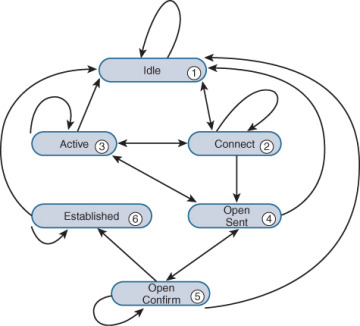Introduction
In the realm of networking and internet communication, the Border Gateway Protocol (BGP) plays a pivotal role in facilitating the exchange of routing information between autonomous systems. BGP operates through a series of states that govern the establishment, maintenance, and termination of connections between routers. In this article, we will explore the different BGP states and delve into the intricacies of how routing information traverses these states to reach its destination.
The BGP States
BGP operates through four primary states, each representing a different stage in the process of establishing and maintaining connections between routers. Following are the BGP states:
Idle State
The Idle state is the initial state of a BGP connection. In this state, the router has not yet initiated any BGP connections or established any peering relationships with neighboring routers. The router remains idle, waiting for a BGP neighbor connection to be established.
Connect State
Once a router initiates a TCP connection with a neighboring router, it enters the Connect state. During this state, the routers exchange TCP packets to establish a reliable and stable connection. If the TCP connection is successful, the router proceeds to the next state. Otherwise, it returns to the Idle state and retries the connection.
OpenSent State
Upon successful TCP connection establishment, the router transitions to the OpenSent state. In this state, the routers exchange BGP Open messages, which contain information such as the BGP version number, the router’s BGP identifier, and other parameters. These messages help establish compatibility and synchronize the BGP configuration between the routers.
OpenConfirm State
After exchanging BGP Open messages, the routers enter the OpenConfirm state. In this state, the routers verify the received Open messages and acknowledge their acceptance. Once both routers have confirmed the Open messages, they proceed to the next state.
Established State
The Established state represents the final stage of the BGP connection process. In this state, the routers have successfully established a BGP peering relationship and can exchange routing information. The routers share their respective routing tables and updates, enabling the dissemination of routing information across autonomous systems.
The Journey of Routing Information
The BGP states are not static; they represent a dynamic process through which routing information travels. Let’s follow the journey of routing information as it traverses the BGP states:
- Idle State: In the Idle state, the router has no knowledge of any BGP routes. It waits for a TCP connection to be initiated.
- Connect State: Once a TCP connection is initiated, the routers exchange TCP packets to establish a reliable connection. If the connection is successful, the router moves to the next state.
- OpenSent State: In the OpenSent state, BGP Open messages are exchanged between the routers to establish compatibility and synchronization. The routers negotiate parameters and confirm the acceptance of the Open messages.
- OpenConfirm State: Upon successful negotiation and acceptance of Open messages, the routers transition to the OpenConfirm state. They verify the received information and acknowledge the acceptance.
- Established State: Finally, in the Established state, the routers have established a BGP peering relationship. They can now exchange routing information, including their routing tables and updates, allowing for the dissemination of routing information between autonomous systems.
It’s important to note that routing information can also traverse back through the BGP states if changes occur or if there are disruptions in the connection.
Frequently Asked Questions (FAQs)
What happens if the TCP connection fails during the Connect state?
If the TCP connection fails during the Connect state, the router returns to the Idle state and retries the connection. It continues this process until a successful TCP connection is established.
Can a router be in multiple BGP states simultaneously?
No, a router can only be in one BGP state at a time. The transition from one state to another occurs sequentially as the BGP connection progresses.
No, a router can only be in one BGP state at a time. The transition from one state to another occurs sequentially as the BGP connection progresses.
The time it takes for a BGP connection to reach the Established state can vary depending on factors such as network conditions, router configurations, and the complexity of the routing environment. In optimal conditions, the process typically occurs within seconds or minutes.
What happens if there is a change in routing information during the Established state?
If there is a change in routing information during the Established state, the routers exchange updates to reflect the changes. BGP uses a series of mechanisms, such as route advertisements and withdrawals, to ensure the timely dissemination of routing information.
Can a router skip certain BGP states?
No, the BGP states must be traversed sequentially. A router cannot skip states in the process of establishing a BGP connection.
What is the significance of the Established state in BGP?
The Established state is crucial as it signifies the successful establishment of a BGP peering relationship. It allows routers to exchange routing information, enabling efficient and reliable routing across autonomous systems.
Conclusion
Understanding the BGP states is essential for comprehending the journey of routing information within the Border Gateway Protocol. From the initial Idle state to the final Established state, routers go through a dynamic process of connection establishment and synchronization. By grasping the intricacies of these states, network administrators and engineers can effectively manage BGP connections and ensure the seamless flow of routing information across autonomous systems.
